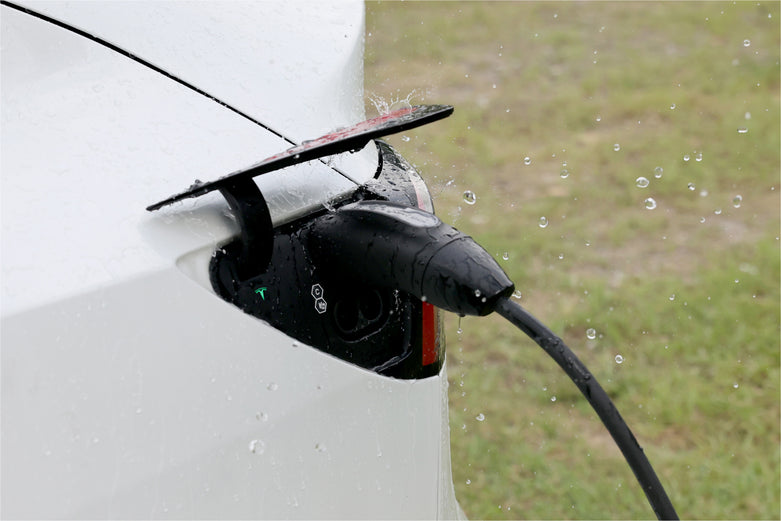
How to Get 40A Charge at Home for Your Tesla?
การชาร์จเทสลาของคุณอย่างมีประสิทธิภาพที่บ้านเป็นสิ่งสำคัญไม่เพียง แต่เพื่อความสะดวก แต่ยังรักษาประสิทธิภาพของยานพาหนะของคุณด้วย มาขุดลึกลงไปในข้อกำหนดการชาร์จ 40A ผลประโยชน์และกระบวนการตั้งค่าทั้งหมด
ข้ามไปที่ส่วน
ทำไมต้องชาร์จ 40A ที่บ้าน ?
ด้วยซุปเปอร์ชาร์จเจอร์ที่เพียงพอรอบ ๆ คุณอาจสงสัยว่าทำไมการชาร์จ 40A จึงจำเป็นต้องใช้ที่บ้านหลังจากทั้งหมดคุณกำลังเรียกเก็บเงินข้ามคืนและไม่ได้รับผลกระทบจากการชาร์จที่ช้าลง แต่คุณควรตระหนักถึงประโยชน์ด้านล่างของการชาร์จที่เร็วขึ้นที่บ้าน
- การชาร์จที่สูงขึ้นต่อชั่วโมง: เครื่องชาร์จ 40A สามารถเพิ่มช่วงได้ถึง 30 ไมล์ต่อชั่วโมงของการชาร์จเมื่อเทียบกับ 3-4 ไมล์ต่อชั่วโมงโดยทั่วไปที่จัดทำโดยเต้าเสียบมาตรฐาน 120V สิ่งนี้จะช่วยลดเวลาที่จำเป็นในการชาร์จ Tesla ของคุณอย่างเต็มที่
- เปิดใช้งานการเดินทางทางไกลทางไกล: ในขณะที่เครื่องชาร์จ 40A ลดเวลาที่ใช้ในการชาร์จเทสลาของคุณอย่างแน่นอน ในเทสลาของคุณสะดวกและยืดหยุ่นมากขึ้น นี่คือคู่มือ ที่สมบูรณ์ เกี่ยวกับวิธีเพิ่มประสิทธิภาพการชาร์จของคุณขณะเดินทางบนท้องถนน
- การปรับปรุงสุขภาพของแบตเตอรี่: การชาร์จในอัตราปานกลางเช่น 40A ดีกว่าสำหรับสุขภาพระยะยาวของแบตเตอรี่เทสลาของคุณเมื่อเทียบกับความเร็วในการชาร์จอย่างรวดเร็วของซุปเปอร์ชาร์จเจอร์ การชาร์จช้าลงช่วยลดความร้อนและความเครียดของแบตเตอรี่ซึ่งอาจยืดอายุการใช้งานได้
- ค่าใช้จ่ายในการชาร์จลดลง: การชาร์จที่บ้านในช่วงเวลานอกเวลาที่มีราคาถูกกว่ามากเมื่อเทียบกับการใช้สถานีชาร์จสาธารณะหรือซูเปอร์ชาร์จเจอร์ คุณสามารถค้นหาข้อมูลชีวิตจริงในบล็อกที่กล่าวถึงข้างต้นซึ่งการเดินทาง 4,249 ไมล์ในโคโลราโดมีค่าใช้จ่ายเพียง $ 257.30 ในการชาร์จนั่นคือเพียง 6.06 ¢ต่อไมล์!
- การเตรียมความพร้อมฉุกเฉิน : การชาร์จ 40A ทำให้มั่นใจได้ว่าเทสลาของคุณพร้อมที่จะไปเสมอให้ความอุ่นใจในกรณีที่มีการเดินทางหรือฉุกเฉินที่ไม่คาดคิด
วิธีรับการชาร์จ 40A ที่บ้าน ?
ตอนนี้ทำไมส่วนที่เรียงลำดับแล้วนี่คือส่วนหนึ่ง - คู่มือขั้นตอนที่ชาญฉลาดสำหรับการบรรลุการชาร์จดังกล่าวที่บ้าน
ขั้นตอนที่ 1: รับการตั้งค่าไฟฟ้าที่จำเป็น
เพื่อให้ได้การชาร์จ 40A ที่บ้านคุณต้องมีวงจร 240V โดยเฉพาะพร้อมเบรกเกอร์ 50A การตั้งค่านี้ช่วยให้มั่นใจได้ว่าสถานีชาร์จของคุณสามารถส่งมอบพลังงานที่จำเป็นได้อย่างปลอดภัยและมีประสิทธิภาพ
เพื่อให้บรรลุว่าคุณต้องทำตามขั้นตอนด้านล่าง:
1 การประเมินแผงไฟฟ้า :
- ตรวจสอบว่าแผงไฟฟ้าของบ้านของคุณสามารถรองรับวงจร 50A เพิ่มเติมได้หรือไม่
- หากแผงของคุณเต็มหรือเก่าเกินไปคุณอาจต้องอัพเกรด
2 การติดตั้งมืออาชีพ :
- จ้างช่างไฟฟ้าที่ได้รับใบอนุญาตเพื่อติดตั้งวงจรใหม่
- ตรวจสอบให้แน่ใจว่าการติดตั้งเป็นไปตามรหัสไฟฟ้าและข้อบังคับในท้องถิ่น
3 เลือกตำแหน่ง :
- เลือกจุดที่สะดวกและเข้าถึงได้ในโรงรถของคุณหรือใกล้กับที่จอดรถของคุณ
- ตรวจสอบให้แน่ใจว่าตำแหน่งอยู่ใกล้กับสายชาร์จของคุณ
4ติดตั้ง Outlet :
- ให้ช่างไฟฟ้าติดตั้งเต้าเสียบ NEMA 14-50 และเชื่อมต่อกับวงจร 50A โดยเฉพาะ
- ตรวจสอบให้แน่ใจว่าลวดเชื่อมต่อจากทางออกไปยังแผงไฟฟ้ารองรับการชาร์จ 50A เพื่อหลีกเลี่ยงความร้อนสูงเกินไป
- ใช้กล่องเต้าเสียบกันน้ำถ้าติดตั้งเต้าเสียบกลางแจ้ง
5 ทดสอบทางออก : ตรวจสอบการทำงานของทางออกก่อนที่จะเชื่อมต่ออุปกรณ์ชาร์จของคุณ
หากคุณไม่แน่ใจว่าจะเลือกร้านไหนให้คว้า NEMA 14-50 Box Outlet Outlet Power Power ของเรา ได้รับการออกแบบมาเพื่อเสนอการเชื่อมต่อ 240V/50A ที่จำเป็น โดยทั่วไปแล้วเป็นทางออกที่ใช้งานหนักสำหรับเตาไฟฟ้าและ RVs ทำให้ดีสำหรับการชาร์จ EV
ขั้นตอนที่ 2: รับอะแดปเตอร์ตัวเชื่อมต่อมือถือที่เหมาะสม
เมื่อคุณทดสอบเต้าเสียบแล้วคุณควรเดินต่อไปเพื่อรวบรวมอุปกรณ์ชาร์จที่เหมาะสม มี 2 สิ่งที่ต้องพิจารณา - ตัวเชื่อมต่อการชาร์จและอะแดปเตอร์เชื่อมต่อ ในขณะที่เราจะมาที่ขั้วต่อในภายหลังก่อนอื่นมาทำความเข้าใจกับข้อกำหนดของอะแดปเตอร์
ก่อนอะแดปเตอร์ตัวเชื่อมต่อมือถือใดที่ดีที่สุดสำหรับคุณ ?
อะแดปเตอร์ขั้วต่อมือถือเป็นองค์ประกอบสำคัญของการตั้งค่าการชาร์จ EV ของคุณ มันทำหน้าที่เป็นสะพานเชื่อมระหว่างสายเคเบิลชาร์จของคุณและแหล่งพลังงานทำให้มั่นใจได้ว่าการเชื่อมต่อที่ปลอดภัยและมีประสิทธิภาพ
ในขณะที่กล่องเต้าเสียบอธิบายในขั้นตอนที่ 1 จะให้แพลตฟอร์มสำหรับพลังงานที่ต้องการ แต่อะแดปเตอร์คือสิ่งที่ส่งพลังงานนั้นไปยังขั้วต่อมือถือของคุณ
Tesla เสนออะแดปเตอร์ที่หลากหลายสำหรับสถานการณ์การชาร์จที่แตกต่างกันตั้งแต่ NEMA 5-20 ถึง NEMA 14-50 อย่างไรก็ตามพวกเขาจะถูกสูงสุดที่ 32A
โดยคำนึงถึงสิ่งนี้เราได้รวม Adapter NEMA 14-50 ตัวเชื่อมต่อมือถือตัวเชื่อมต่อมือถือ ด้วยตัวเชื่อมต่อมือถือของเรา มีความทนทานของสายเคเบิลที่เหนือกว่าด้วยการใช้สายเคเบิลเส้นผ่านศูนย์กลางลวด 17 มม.
นี่คือประโยชน์สูงสุด:
- สายไฟที่หนาขึ้น: สายที่ใช้นั้นหนากว่าสายเคเบิล 12 มม. มาตรฐานของเทสลา 40% ทำให้เหมาะสำหรับการใช้งานหนักมากขึ้นรองรับกระแสสูงสุดที่สูงถึง 40A %.
- การป้องกันเทอร์มินัลขั้นสูง : เทอร์มินัลปลายทางของอะแดปเตอร์ของเราเสร็จสิ้นด้วยการเคลือบชุบสังกะสีคุณภาพสูงซึ่งให้ความต้านทานต่อการกัดกร่อนและออกซิเดชั่นที่ยอดเยี่ยม
- การชาร์จที่ปลอดภัยยิ่งขึ้น: การเคลือบแบบชุบสังกะสีทำหน้าที่เป็นชั้นป้องกันทำให้มั่นใจได้ว่าประสบการณ์การชาร์จของคุณนั้นไม่หยุดชะงักและปลอดภัยแม้ในสภาพแวดล้อมที่ชื้นที่สุด
- ชิปควบคุมอุณหภูมิที่เป็นนวัตกรรม : มันตรวจสอบอุณหภูมิการชาร์จอย่างแข็งขันหยุดการชาร์จโดยอัตโนมัติในการตรวจจับความร้อนที่มากเกินไปและป้องกันยานพาหนะของคุณจากอันตรายที่อาจเกิดขึ้น
ขั้นตอนที่ 3: รับตัวเชื่อมต่อมือถือที่เหมาะสม
ถัดไปคุณจะต้องมีตัวเชื่อมต่อมือถือที่เหมาะสมสำหรับการตั้งค่าการชาร์จ 40A EV ของคุณ
คุณต้องพิจารณาสิ่งต่อไปนี้ในขณะที่รับขั้วต่อที่เหมาะสม
- ความเข้ากันได้ของยานพาหนะ : ตรวจสอบให้แน่ใจว่าตัวเชื่อมต่อมือถือเข้ากันได้กับรุ่นเทสลาเฉพาะของคุณ
- ประเภทตัวเชื่อมต่อ : ตรวจสอบให้แน่ใจว่าประเภทตัวเชื่อมต่อตรงกับพอร์ตการชาร์จของยานพาหนะของคุณ เทสลามักจะมี พอร์ตการชาร์จ NACS หากขั้วต่อของคุณไม่มีซ็อกเก็ต NACS คุณสามารถใช้อะแดปเตอร์ NACS เพื่อเสียบในรถของคุณ
- แอมแปร์ที่รองรับ: ตรวจสอบว่าขั้วต่อมือถือรองรับการชาร์จ 40A ตัวเชื่อมต่อทั้งหมดไม่ได้รับการออกแบบมาเพื่อจัดการระดับกระแสไฟฟ้านี้ดังนั้นจึงเป็นสิ่งสำคัญในการตรวจสอบข้อมูลจำเพาะ
- สร้างคุณภาพ: มองหาขั้วต่อที่ทำจากวัสดุคุณภาพสูงที่สามารถทนต่อการใช้งานและสัมผัสกับองค์ประกอบเป็นประจำหากใช้กลางแจ้ง
- การป้องกันกระแสเกิน : ตัวเชื่อมต่อควรมีการป้องกันกระแสเกินในตัวเพื่อป้องกันความผิดพลาดทางไฟฟ้า
- การตรวจสอบความร้อน : เลือกขั้วต่อที่มีการตรวจสอบความร้อนเพื่อหลีกเลี่ยงความร้อนสูงเกินไปในระหว่างการชาร์จ
- ความต้านทานสภาพอากาศ : หากคุณวางแผนที่จะใช้ตัวเชื่อมต่อกลางแจ้งตรวจสอบให้แน่ใจว่าทนต่อสภาพอากาศเพื่อป้องกันฝนหิมะและองค์ประกอบอื่น ๆ
- การออกแบบปลั๊กและเล่น : เลือกใช้ตัวเชื่อมต่อที่ง่ายต่อการตั้งค่าและใช้งานโดยไม่ต้องใช้ขั้นตอนการติดตั้งที่ซับซ้อน
- พกพา : การออกแบบที่มีขนาดกะทัดรัดและพกพาทำให้สะดวกในการพกพาและใช้ในสถานที่ต่าง ๆ
- ความยาวสายเคเบิล : ตรวจสอบให้แน่ใจว่าความยาวของสายเคเบิลนั้นเพียงพอที่จะเข้าถึงจากทางออกของคุณไปยังรถของคุณได้อย่างสะดวกสบาย
- ความสามารถในการตรวจสอบ : ตัวเชื่อมต่อบางตัวมีคุณสมบัติเช่นการตรวจสอบสถานะการชาร์จผ่านแอพซึ่งอาจเป็นการเพิ่มที่มีประโยชน์
ในขณะที่มองหาตัวเชื่อมต่อที่สมบูรณ์แบบอาจดูเหมือนว่ากำลังหาเข็มใน Ha
JOWUA
yle="text-decoration: underline; color: rgb(255, 255, 255);"> yle="text-decoration: underline; color: rgb(255, 255, 255);" rel="noopener" href="https://www. | yle="text-decoration: underline; color: rgb(255, 255, 255);"> yle="text-decoration: underline; color: rgb(255, 255, 255);" rel="noopener" href="https://www. |
ตัวเชื่อมต่อมือถือเหล่านี้ได้รับการออกแบบมาเป็นพิเศษเพื่อช่วยให้เจ้าของเทสลาได้รับค่าใช้จ่าย 40A ที่บ้าน
นี่คือคุณสมบัติยอดนิยมบางส่วน:
1 ความเข้ากันได้ : J1772
อย่างไรก็ตามหากคุณต้องการโซลูชัน NACS-onl
2 ความทนทานและการชาร์จที่มั่นคง: สร้างด้วยวัสดุคุณภาพสูงสำหรับการใช้งานที่ยาวนาน ตัวเชื่อมต่อมีขั้วนิกเกิลและชุบเงินซึ่งทนต่อการกัดกร่อนและทนทานได้มั่นใจได้ว่าค่าการนำไฟฟ้าที่มั่นคงและป้องกันกางเกงขาสั้นในสภาพแวดล้อมที่ชื้นเช่นไต้หวัน
3 ใช้งานง่าย : การตั้งค่าแบบปลั๊กแบบง่าย ๆ
4 40A/9.6KW การชาร์จพิเศษ:ติดตั้งสายเคเบิลระดับสูงที่ผ่านการรับรอง UL ที่ชาร์จของเรารองรับกระแสสูงถึง 40A สูงกว่ามาตรฐาน 32A 25% เพิ่มประสิทธิภาพการชาร์จและรักษาความปลอดภัยโดยลดการสร้างความร้อน ขึ้น. (หมายเหตุ: มาตรฐานยุโรปคือ 32A)
5 การชาร์จตามกำหนดเวลา:ด้วย Wi-Fi ในตัวคุณสามารถกำหนดค่าการชาร์จในช่วงนอกเวลาที่มีอัตราสูงสุดในอัตราที่ต่ำกว่า ปรับการตั้งค่าพลังงานและการตรวจสอบอุณหภูมิอย่างสะดวก
6 สารกันฝุ่นและน้ำ IP55:ขั้วต่อถูกปิดผนึกอย่างเต็มที่เพื่อป้องกันฝุ่นและน้ำ
7UL94 V-0 Flame สารหน่วง: ตัวเชื่อมต่อมีความต้านทานเปลวไฟระดับสูงสุดและฟังก์ชั่นการขยายตัวเอง
8 เอาท์พุทสูงสุดที่สูงกว่า: เมื่อเทียบกับอะแดปเตอร์ NEMA 14-50 ของ Tesla ซึ่งมีเอาต์พุตสูงสุด 32A, อะแดปเตอร์
ขั้นตอนที่ 4: การแก้ไขปัญหาและการบำรุงรักษา
ในที่สุดตามขั้นตอน 3 ขั้นตอนข้างต้นคุณควรได้รับการชาร์จ 40A ที่จำเป็นคุณต้องใช้ความระมัดระวังเสมอในขณะที่ต้องรับมือกับอุปกรณ์ไฟฟ้าพลังงานสูง นี่คือปัญหาทั่วไปและมาตรการความปลอดภัยที่จะดำเนินการ:
ปัญหาทั่วไป:
- ปัญหาการเชื่อมต่อ : ตรวจสอบให้แน่ใจว่าการเชื่อมต่อทั้งหมดปลอดภัยและจัดตำแหน่งอย่างเหมาะสม
- การหยุดชะงักของการชาร์จ : ตรวจสอบปัญหาแหล่งจ่ายไฟหรืออุปกรณ์ที่มีศักยภาพผิดปกติ
- ความร้อนสูงเกินไป : ตรวจสอบให้แน่ใจว่าการตั้งค่าของคุณมีการระบายอากาศอย่างเพียงพอและไม่ได้รับความร้อนมากเกินไป
เคล็ดลับการบำรุงรักษา:
- การตรวจสอบปกติ : ตรวจสอบอุปกรณ์ชาร์จของคุณเป็นระยะเพื่อการสึกหรอ เป็นระยะ ๆ
- การเชื่อมต่อที่สะอาด: ให้ขั้วต่อและร้านค้าเป็นอิสระจากฝุ่นและเศษซาก
- การตรวจสอบระดับมืออาชีพ: มีช่างไฟฟ้าที่ผ่านการรับรองตรวจสอบการตั้งค่าของคุณเป็นประจำทุกปี
บทสรุป
การตั้งค่าสถานี 40A ที่บ้านสำหรับเทสลาของคุณสามารถเพิ่มประสิทธิภาพการชาร์จของยานพาหนะและความสะดวกโดยรวมของคุณ
yle="text-align: left;">เช่นเดียวกับสิ่งที่คุณได้อ่าน ? สมัครสมาชิกจดหมายข่าวของเราและเรียกดูผู้ขายที่ดีที่สุดสำหรับข้อมูลเพิ่มเติม





Leave a comment
เว็บไซต์นี้ได้รับการคุ้มครองโดย hCaptcha และมีการนำนโยบายความเป็นส่วนตัวของ hCaptcha และข้อกำหนดในการใช้บริการมาใช้